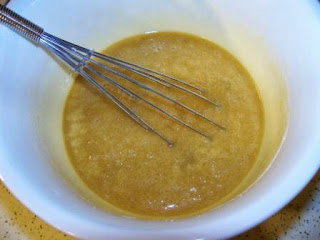Spiced Rum Pound Cake with Sauted Pineapple and Toasted Coconut Flakes
Spiced Rum Pound Cake
2 sticks butter (1 cup), room temp
1/2 cup shortening
3 cups sugar
5 large eggs, beaten
3-1/2 cups flour
1/2 tsp baking powder
1 cup milk
1/4 cup spiced rum
1 tsp vanilla
1/3 cup roast almonds
In a large mixing bowl, cream butter and shortening until smooth. I find this is easier to do if you cut the butter into smaller pieces first.
Gradually add in the sugar and mix until well-blended.
Alternately add in flour mixture and milk mixture, blend until the batter is light and fluffy. I usually add 1/3 flour -- 1/2 milk -- 1/3 flour -- 1/2 milk -- 1/3 flour.
Remove from over and allow to sit for 5 minutes or so before removing from pan.
fresh pineapple, peeled, cored, chopped
coconut vinegar
Use 2 tbsp of coconut vinegar for every 1 cup of pineapple pieces.
In a skillet over high heat, cook pineapple pieces for 2-3 minutes, stirring constantly. Add coconut vinegar to the pineapple and continue to cook, stirring constantly.
Toasted Coconut
coconut flakes
In a small skillet over high heat, cook coconut flakes for 3-4 minutes or until they start turning brown.
Assemble
Cut a wedge of pound cake, cover with sauted pineapple pieces and garnish with toasted coconut and serve.
NOTES
FYI: 5 large eggs = 8 oz (1 cup), 7 large eggs minus yolk = 8 oz (1 cup) egg whites
If you want to use rum flavoring instead of actual rum then change the liquid measures to 2 tsp rum flavor, 2 tsp vanilla, 1 cup + 3 tbsp milk.
It's good to give the cake time to sit before depanning, otherwise if you rush the process and flip it out before it's had time to seize up a bit, it might split (like mine did). The other reason mine may have split is because the cake baked up over the edges so it didn't have a flat bottom when turned, if yours is mounded when it comes out, you can always trim off the extra before plating.
You can order coconut vinegar online from Olive & Kickin' or check out a local specialty food store. Whole Foods carries a brand and you can probably find some at Southern Season in Chapel Hill.
I found coconut flakes at Kroger, but most grocery stores will carry shredded or flaked coconut that you can use in lieu of.





















































